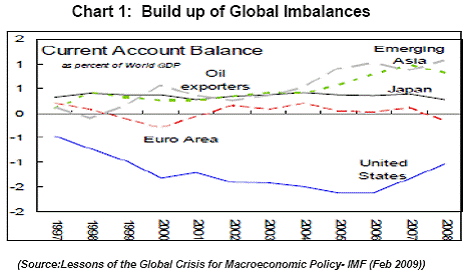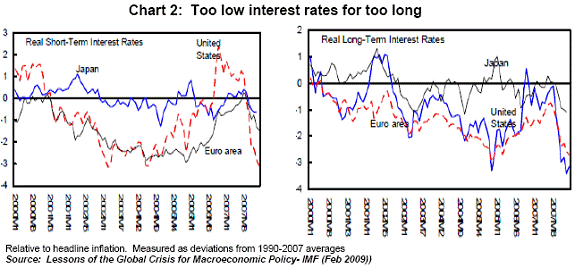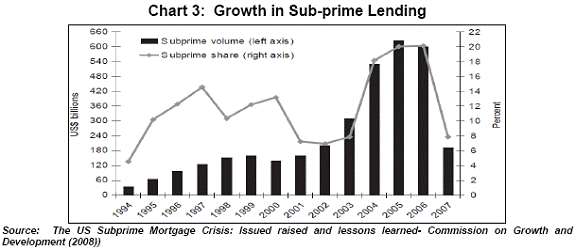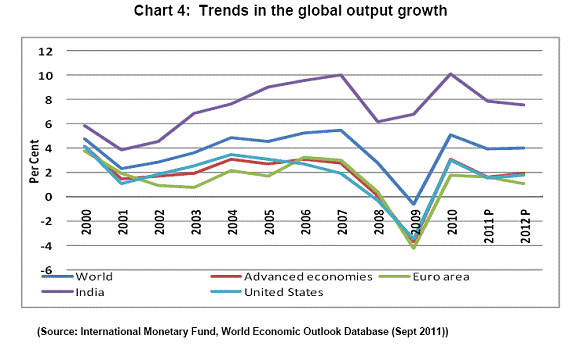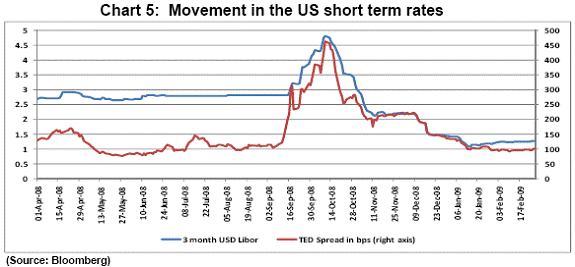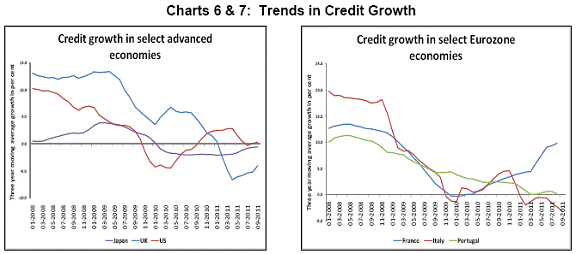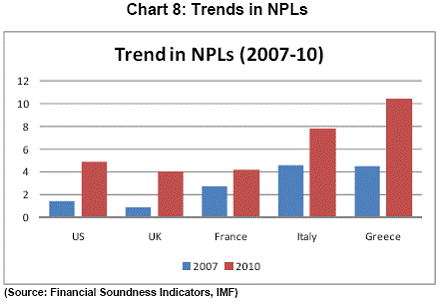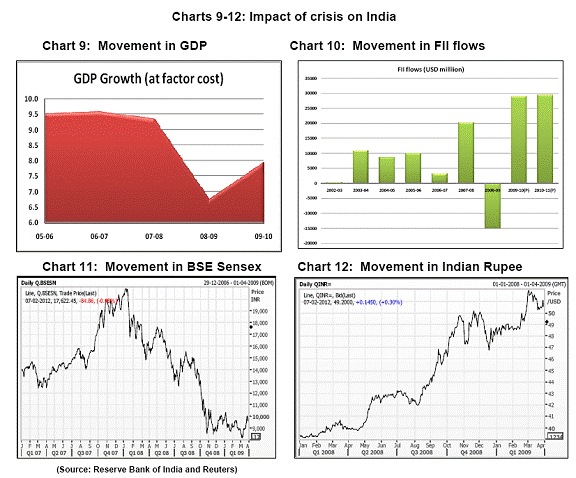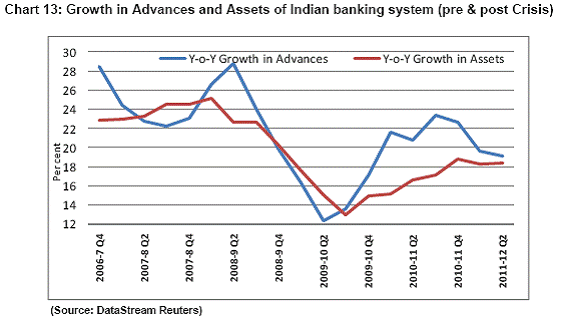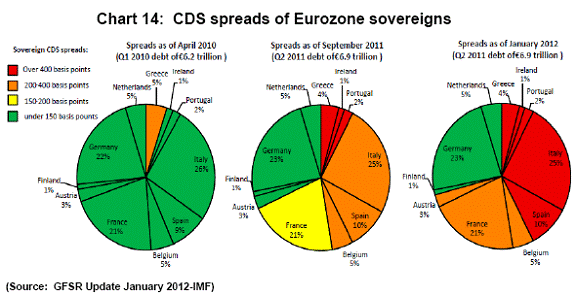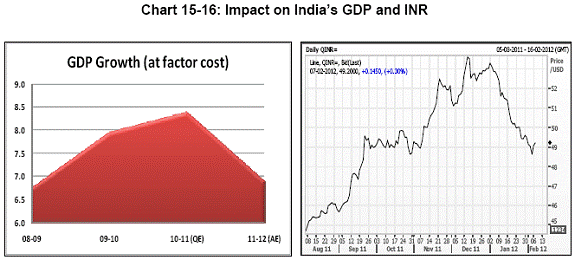 IST,
IST,


Changing Contours of Global Crisis- Impact on Indian Economy
Shri Anand Sinha, Deputy Governor, Reserve Bank of India
Delivered on Mar 20, 2012
Dr. Devi Singh, Director, IIM Lucknow and Mentor Director, IIM Kashipur; Professor Manoj Anand; other members of the faculty; my fellow bankers and the young and ‘raring to go’ students of Indian Institute of Management, Kashipur. A very good evening to you all. I deem it a privilege to address young and bright students like this. I see in them the willingness to listen, courage to question and the enthusiasm to take on challenges that the future holds for them. In short, I see in them, the answers to the challenges we face today. It is always energizing as well as educating to interact with students and that is the precise reason why I had no second thoughts in accepting the invitation to interact with them even at a place far off from my workplace, Mumbai. 2. IIM, Kashipur is the youngest IIM. There is a benefit in being young in the group. You have a pool of experience to choose from and to learn. At the same time, the challenges of being young in the group are also quite daunting. You are expected to reach and maintain the heights reached by your seniors and even surpass them. Looking at the enthusiasm of the students today, I am sure IIM, Kashipur will soon emerge as one of the premier institutions among IIMs. 3. The topic chosen for today’s address, on the face of it, looks quite jaded. So much has already been said, discussed, analysed, dissected and written about the crisis. The crisis which erupted in 2007 has, in no time, engulfed the consciousness of the public so much, that no finance speech is complete without a reference to it nor is a finance book consummate without a chapter devoted. Going by the number of books published on crisis, one would not be greatly surprised if publishing industry was one of the few industries that stayed afloat, or in fact, thrived during the crisis. 4. Then, why am I deliberating on a topic which has been discussed so much already? It is because of two reasons- One, this crisis still continues to offer a wealth of information and lessons, which will remain relevant in times to come. Second, the crisis does not remain what it was, when it started. The crisis which started off as a localized sub-prime crisis has morphed into a financial crisis leading to a full blown global economic crisis and has now taken the shape of a sovereign debt crisis. While its current spread is localized in Eurozone, its impact continues to be felt all across the globe. It is in this context that I would place my talk today on the changing contours of crisis and its impact on the Indian economy. I. Calm before the storm- A period of great moderation 5. The period preceding the Global Crisis was a phase of Great Moderation representing the decline in macroeconomic volatility (both output as well as inflation). The period was marked by strong worldwide GDP growth coupled with low or stable inflation and very low interest rates which lulled the policy makers and the economists into believing that their search for ‘holy grail’ was over and the magic formula of strong growth with low inflation had been finally discovered. The great moderation was attributed1 to (i) structural changes that may have increased macroeconomic flexibility and stability such as improved management of business inventories made possible by advances in computation and communication, increased depth and sophistication of financial markets, deregulation in many industries, the shift away from manufacturing to services and increased openness to trade and international capital flows etc. (ii) improved performance of macroeconomic policies or (iii) good luck. The role of good luck in maintaining great moderation was extensively discussed and debated and, as anyone would expect, its role was discounted when things were going good. 6. The problem in attributing entire credit to good luck is that it leaves you unprepared and vulnerable to shocks since, by relying solely on luck, you become effectively, a prisoner of circumstances. On the other hand, not giving luck its rightful due encourages you to overrate yourself and leaves you underprepared when a crisis hits. 7. Whatever was the reason, the good times did not last long and the period of great moderation came to an end by 2007 when the crisis erupted. The impact of the crisis on financial world was immense. The global growth slumped, unemployment burgeoned, interbank markets froze on account of heightened counterparty concerns and risk aversion, banking activity plummeted while the non-performing loans increased and many large and famous institutions were obliterated from the face of financial world. The impact of the crisis on the non-financial front was no less. In fact, the crisis caused deeper impact on the intellectual world, by rubbishing concepts and theories that were held sacrosanct till then. Analysts, researches and policymakers huddled to diagnose the reasons for the crisis and came out with various theories and explanations. The more plausible explanation goes this way. Differences in the consumption and investment patterns among countries (a saving glut in Asia and oil exporting countries and a spending binge in the United States) have resulted in emergence of global imbalances which led to large capital flows from surplus countries into deficit countries which were mostly the advanced countries.
8. These capital flows have resulted in a surge of liquidity in advanced economies leading to low interest rates. Both the short term as well as the long term real interest rates remained too low for a too long period. Low interest rates forced the investors to hunt for yield which sowed the seeds for asset inflation. Financial engineering assumed the centre stage in a bid to design and offer high yielding products to investors.
9. In addition to the above factors, gaps in the regulatory framework also played their part in accentuating crisis. The following reasons are widely attributed to the outbreak of crisis- inadequate quantity and quality of capital, insufficient liquidity buffers, excessively leveraged financial institutions, inadequate coverage of certain risks, absence of a regulatory framework for addressing systemic risks, proliferation of opaque and poorly understood financial products in search of yields in the backdrop of an era of ‘great moderation’, perverse incentive structure in securitisation process, lack of transparency in OTC markets particularly the CDS, inadequate regulation and supervision, and a burgeoning under/unregulated shadow banking system. 10. While all these factors were playing in the background creating a perfect recipe for the crisis, the most proximate cause for the Crisis was the developments in the US subprime market. As observed by Raghuram Rajan2, growing income inequality in the United States, stemming from unequal access to quality education, led to political pressure for more housing credit which led to distorted lending in the financial sector. In a classic case of best intentions leading to worst outcomes due to bad implementation, the envisaged policy of financial inclusion by enabling homeless to own homes, led to reckless lending in sub-prime market and, eventually, resulted in a meltdown.
11. The crisis, when erupted in 2007, started off as a mere sub-prime crisis localized in the US. But soon the crisis spread to other markets cutting across geographical boundaries signifying the extent of the global integration. The subprime crisis became a banking crisis due to the exposures banks had to the subprime assets which were fast turning bad. Counterparty concerns exacerbated, leading to freezing of global interbank markets. The crisis had spread to other jurisdictions through various channels of contagion- trade, finance and most importantly, confidence. Foreign investors started withdrawing investments from emerging markets pushing them also into liquidity crisis. By Oct 2008, when Lehman Brothers had collapsed under the weight of sub-prime exposures, the crisis had become truly global, both in spread and impact. 12. The crisis had a devastating impact on the world economy in terms of output losses and rise in unemployment. It had impacted all the segments of the global financial markets in terms of heightened volatility, tighter credit conditions, low asset prices and increased write downs. The policy makers, regulators and the sovereigns had to immediately step in and initiate measures to mitigate the impact of crisis. There have been many measures, both conventional and unconventional, that were taken which provided relief to the badly battered global economy. 13. Just when we thought the crisis was behind us, with economies slowly limping back to normalcy, another crisis hit the World. In a classic case of cure being more painful than the disease, various fiscal measures taken to mitigate the impact of 2007 crisis have, along with other factors, led to huge and unsustainable sovereign debts resulting in a sovereign debt crisis in Eurozone. Countries that have run up huge fiscal deficits, either to maintain populist policies or to bail out institutions during the global crisis by guaranteeing failing banks etc., have suddenly found themselves on the verge of bankruptcy unable to honour their obligations and the word ‘sovereign debt’ suddenly ceased to evoke images of a riskless (less risky, at least) asset. 14. With this background in place, I would now move on to the central theme of the talk today ‘Changing Contours of global Crisis- Impact on Indian Economy’. I intend to cover the impact of both the crises i.e. Global Crisis 2007 and the current sovereign debt crisis, on Global and Indian economies with specific focus on real sector, financial markets and the banking system.II. Global Crisis a. Impact on Global economy 15. Following the collapse of Lehman Brothers in September 2008, the global inter-bank financial markets froze in view of large losses suffered by the major financial institutions and the extreme uncertainty over the health of the counterparty balance sheets. This had a knock on effect on various segments of financial markets, including inter-bank markets. Fire sales by investors contributed to further downward pressures on asset prices, leading to a vicious cycle of distress sales and declining asset prices. Heightened risk aversion and search for safe havens led to deleveraging by investors and consequent sharp and substantial retrenchment in capital flows to emerging and developing economies. All this turmoil in various segments of the financial markets led to a sharp decline in economic activity in the major advanced economies. Unemployment rates soared and labour markets became weak. Given the high and growing degree of trade and financial integration between the advanced economies and the Emerging and Developing Economies (EDEs), activity in the EDEs also decelerated sharply. 16. Real GDP growth in advanced economies turned negative in 2009 (- 3.7 per cent) from the strong pace of 2.9 per cent during 2004-07. Growth recovered modestly in 2010, but again turned anaemic in 2011 (1.6 per cent). Growth in advanced economies averaged a mere 0.3 per cent during 2008-11 and output still remains well below potential. The IMF expects growth in advanced economies to decelerate further to 1.2 per cent in 2012. Unemployment rate in the US more than doubled from 4.4 per cent in December 2006 to a peak of 10.0 per cent in October 2009; it has since then eased, at a very gradual pace, to 8.5 per cent.
17. Capital flows (net) to EDEs more than halved from US $ 715 billion in 2007 to US $ 246 billion in 2008 as portfolio and banking flows turned negative. Reflecting the growth shock in the advanced economies as well as the retrenchment in capital flows, real GDP growth in the EDEs decelerated from 8.0 per cent during 2004-7 to 2.8 per cent in 2009. It recovered quickly to 7.3 per cent in 2010. Overall, global GDP growth contracted to 0.6 per cent in 2009 from the robust growth of 5.0 per cent during 2004-07. 18. In the global credit and money markets, the risk spreads had ballooned during the crisis period. The TED spread3 exceeded 300bps on September 17, 2008 breaking the previous record set after the Black Monday crash of 1987 and, thereafter, reached an all time high of 464 bps on Oct 10, 2008. The 3M LIBOR-3M OIS spread4 touched the high of 364 bps on October 10, 2008 as against the normal level of around 10 bps. The huge risk aversion was reflected in sharp decline in the stock indices across the globe and heightened volatility. Global equity markets witnessed major sell-offs in March 2009. The Dow Jones Industrial Average (DJIA) registered the new twelve-year low of 6,547.05 (on closing basis) on March 9, 2009 and had lost 20% of its value in only six weeks. The VIX index –a widely used measure of market risk and often referred to as the "investor fear gauge" – rose to a record high of 80.86 on November 20, 2008. The yields of the treasury securities plummeted on the back of safe haven demands, with the 10 year US Treasury yield touching a low of 2.05% on Dec 30, 2008. The three month T-Bill yield fell to (-) 4 basis points, the lowest it has been since 1954 reflecting unprecedented flight-to-safety. The CDS spreads widened markedly. The major CDS indices5, i.e. CDX Cross Over, CDX Investment Grade, iTraxx Europe crossover and iTraxx Europe, touched the highs of 699 bps, 242 bps, 1150 bps and 206 bps respectively during March 2009. In a parallel development, while other asset classes have fallen in value, commodity prices surged during this period. Financialisation of commodities is believed to have added to the inflationary pressure. Both Gold and Crude oil prices had spiralled during the period.
19. Global crisis has also severely affected the growth and health of global banking sector. Bank credit growth in major economies such as US, UK, and the Eurozone secularly declined throughout 2009. The asset quality has also been adversely impacted with NPA (as % of total loans) rising to higher levels. The NPAs in the UK and US have risen from 0.9 per cent and 1.4 per cent in 2007 to 4.0 per cent and 4.9 per cent in 2009 respectively. The capital position of the banks, however, remained comfortable with most global banks continuing to step up their capital positions notwithstanding the crisis. By 2010, the Capital to Risk Weighted Assets Ratio (CRAR) was placed above 15 per cent for banks in UK, US, Japan and Germany.
b. Policy Responses: Global 20. In response to the collapse in economic activity, large losses suffered by major banks and financial institutions and severe disruption in financial markets, there was an unprecedented policy response by both monetary and fiscal authorities. Given the severe impact on economic activity and the vicious circle of expectations, the policy response was globally coordinated. As economic activity slowed down sharply, monetary policy was eased aggressively in both advanced economies and EDEs. In major advanced economies, policy interest rates were cut to almost zero levels by early 2009 which stayed around those levels even three years later (as of early 2012). Given the large unemployment rates and negative output gaps, the US Federal Reserve has indicated that the policy rate – the federal funds rate – will remain near zero till late 2014. The policy rate would thus remain near zero for almost six years, going by the Fed’s current assessment. In view of near zero policy interest rates and limitations imposed by the zero bound on the interest rates, the US Federal Reserve and other major central banks in advanced economies have also resorted to unprecedented quantitative easing – substantial infusion of liquidity - in an attempt to ease credit and financing conditions and drive long-term yields lower. 21. Turning to fiscal measures, to begin with, governments in major advanced economies provided direct support to the failing financial institutions. Subsequently, in view of the collapse of growth and the constraints posed by the lower zero bound on the interest rates, governments in almost all jurisdictions resorted to stimulus packages to boost activity. Despite the large fiscal and monetary stimuli, economic activity remained sluggish. C. Impact of Crisis on India 22. The global financial crisis impacted India significantly, notwithstanding the sound banking system, negligible exposure of Indian banks to sub-prime assets and relatively well-functioning financial markets. The impact was mainly on account of India’s growing trade and financial integration with the global economy. India’s two way trade (merchandize exports plus imports), as a proportion of GDP, was 40.7 per cent in 2008-09, the crisis year, up from 19.6 per cent in 1998-99. The ratio of total external transactions (gross current account flows plus gross capital account flows) to GDP – an indicator of both trade and financial integration – was 112 per cent in 2008-09 up from 44 per cent in 1998-99.23. The immediate impact of the crisis was felt through large capital outflows and consequent fall in the domestic stock markets on account of sell-off by Foreign Institutional Investors and steep depreciation of the Rupee against US Dollar. The BSE Sensex (on closing basis), which had touched a peak of 20873 on January 8, 2008, declined to a low of 8160 on March 9, 2009. While the capital outflows led to decline in the domestic forex liquidity, RBI’s intervention in the forex market resulted in tightening of Rupee liquidity. The inter-bank call money (overnight) rates firmed up during the period from second half of September’ 08 to end October’ 08 (high of 19.70 per cent on October 10). However, the series of liquidity augmenting measures undertaken by RBI resulted in call rates coming back to the normal levels from first week of November’08. 24. Global recession had adversely affected the Indian exports resulting in widening of current account deficit (CAD). Exports which grew at 25 per cent during 2005/08 decelerated to 13.6 per cent in the crisis year (2008-09) and registered a negative growth of 3.5 per cent in 2009-10. Output growth, which averaged little less than 9 per cent in the previous five years and 9.5 per cent during the three year period 2005-08, dropped to 6.8 per cent in the crisis year (2008-09). 25. In the pre-crisis years, capital inflows were far in excess of the current account deficit (CAD) and the Reserve Bank had to absorb these flows in its balance sheet. As global investors tried to rebalance their portfolios during the crisis period, the country witnessed large capital outflows immediately after the collapse of Lehman Brothers leading to a downward pressure on the rupee. The exchange rate depreciated from Rs. 39.37 per dollar in January 2008 to Rs. 51.23 per dollar in March 2009.
26. The credit markets also came under pressure as corporates, finding it difficult to raise resources through external sources of funding, turned to domestic bank and non-bank institutions for funding and also withdrew their investments from the liquid schemes of mutual funds. This, in turn, put redemption pressure on mutual funds (MFs) and, further along the chain, on non-banking financial companies (NBFCs) for whom MFs were a significant source of funding. 27. The Indian banking sector has, however, withstood the spillover effects of the global financial crisis as was evident in the robust CRAR and Tier 1 CRAR which remained far above the stipulated regulatory minimum of 9 per cent. The asset quality was also comfortable despite some slippages. By end March 2010, the Gross NPA ratio stood at 2.50 per cent (net NPA 1.13%) while the CRAR was 13.58 per cent. The spillover effects of the crisis were, however, most visible in the credit growth of banking sector. Since September 2008, the growth rate of advances, as also of assets, started witnessing a declining trend which continued for almost one year up to September 2009. The Y-o-Y growth in advances fell from 28.5 per cent at the end March 2007 to 12.3 per cent by end Sept 2009 while the Y-o-Y growth in assets fell from 22.9 per cent to 15.1 per cent during the same period.
d. Policy Response- India 28. Given the deceleration in growth and drying up of capital flows, both the Reserve Bank and the Government undertook a number of measures to minimise the impact of the crisis on India. There was, however, a notable difference between Indian response and those of many EMEs, on the one hand, and the advanced economies, on the other hand. While policy responses in advanced economies had to contend with both the unfolding financial crisis and deepening recession, the Indian response was predominantly driven by the need to arrest moderation in economic growth. The main plank of the government response was fiscal stimulus while the Reserve Bank's action comprised counter-cyclical regulatory measures and also measures to ensure easy liquidity and monetary conditions. 29. The Reserve Bank's policy measures were aimed at containing the contagion from the outside - to keep the domestic money and credit markets functioning normally and ensure that the liquidity stress did not trigger solvency cascades. As in the case of other central banks, both conventional and unconventional measures were undertaken. The conventional measures included, first, a sharp reduction in the policy interest rates – the effective policy rate was cut from 9 per cent (repo rate) in September 2008 to 3.25 per cent (reverse repo rate) in April 2009. Second, the cash reserve ratio was reduced from 9.0 per cent in September 2008 to 5 per cent in January 2009 with a view to injecting liquidity into the banking system. Third, liquidity injection in bulk was made through purchase of government securities under open market operation (OMO) and unwinding of the balances under Market Stabilization Scheme (MSS) through buy-back, redemptions and de-sequestering. Fourth, refinance facilities for export credit were enhanced. Measures were also taken for enhancing forex liquidity which included an upward adjustment of the interest rate ceiling on the deposits by non-resident Indians under FCNR (B) and NRE deposit accounts and relaxation in norms for external commercial borrowings (ECB). In view of the slowing economy and decelerating credit flow, the counter-cyclical regulatory measures introduced in 2006 were also reversed.30. The unconventional measures taken by the Reserve Bank of India included; institution of a rupee-dollar swap facility for Indian banks to give them comfort in managing short-term foreign funding requirements of their overseas branches; special liquidity support to banks for on-lending to mutual funds and non-banking financial companies; liquidity support to non-banking financial companies through a special purpose vehicle created for the purpose and expansion of the lendable resources available to apex finance institutions for refinancing credit extended to small industries, housing and exports. The measures undertaken by the Reserve Bank during September 2008- July 2009 have resulted in augmentation of actual/potential liquidity of Rs. 5, 61,700 cr. 31. The fiscal stimulus measures, undertaken in December 2008 and January 2009, included additional public spending as well as cuts in taxes. These stimulus packages came on top of an already announced expanded safety-net for rural poor, a farm loan waiver package and salary increases for government staff, all of which too stimulated demand. 32. Taken together, the fiscal and monetary measures were successful in achieving their objectives. Financial markets and the banking sector began to function normally. Real GDP growth which took a hit in 2008-09 as it reached 6.8 per cent recovered quickly to reach 8.0 per cent in 2009-10 and 8.5 per cent in 2010-11 under the impact of stimulus measures as also the inherent strength of domestic demand. Strong recovery in demand, along with persistent supply pressures, however, led to inflationary pressures during 2010-2011.e. Why was the impact on India muted? 33. Despite its immediate impact on the financial markets and the trade flows, the crisis did not have very significant impact on the Indian financial system. The reasons for the muted impact is attributable primarily to (i) the macroprudential approach to regulation (ii) multiple indicator based monetary policy, (iii) calibrated capital account management, (iv) management of systemic interconnectedness, (v) robust market infrastructure for OTC transactions and (vi) a conservative approach towards financial innovation. 34. The monetary policy formulation by the Reserve Bank of India has been guided by multiple objectives and multiple instruments contrary to the approach followed by some countries of single objective and single instruments. Monitoring of multiple macroeconomic indicators has helped the Reserve Bank in interpreting developments in financial system and taking prompt corrective action. Similarly, measures such as putting in place robust systems for reducing counterparty risk in OTC transactions through CCP arrangements and regulation of shadow banking institutions to address the interconnectedness issues have helped in containing the impact of the crisis and helping the economy keep afloat despite the huge global turbulences. III. Metamorphosis of the crisis into Sovereign Debt Crisis: 35. Just when the global economy was reverting to the normalcy, another crisis in the nature of sovereign debt crisis surfaced. The growing debts of many European sovereigns caused sustainability concerns forcing investors to withdraw from these markets which led to significant escalation of their CDS spreads. The crisis which emerged in late 2009 has engulfed the entire Eurozone by end 2011. While only Greek bonds had CDS spreads higher than 200 bps in April 2010, by Jan 2012, bonds of all countries except Germany, Finland and the Netherlands had CDS spreads higher than 200 bps. In fact, bonds of PIIGS countries (Portugal, Italy, Ireland, Greece and Spain) had CDS spreads even higher than 400 bps.
36. The combination of sluggish activity, bailouts and fiscal stimulus measures have led to ballooning of fiscal deficits and public debt/GDP ratios in major advanced economies and have raised concerns over fiscal sustainability. These concerns are most visible in euro area countries, which were plagued by various combinations of problems such as over-large banking sector that had become exposed to a housing boom and bust, an uncompetitive economy signaled by repeated current account deficits, and a bloated state sector with high private-sector unemployment6. For example, fiscal deficit/GDP ratios of advanced economies jumped from a near balance position (deficit of 0.6 per cent) in 2007 to 9.0 per cent in 2009, with that of the US jumping from 2.7 per cent to 13.0 per cent over the same period. Fiscal deficits of emerging economies also rose, albeit relatively modestly, from a surplus of 0.1 per cent in 2007 to a deficit 4.8 per cent in 2009. The public debt/GDP ratio for advanced economies increased from 73.4 per cent in 2007 to 93.7 per cent in 2009 and further to 103.5 per cent in 2011. The ratios for Emerging Market Economies (EMEs) over the same years were almost unchanged at 35.9 per cent, 36.7 per cent and 37.8 per cent. 37. The sovereign debt crisis, in a way has completed the circle- during the Global crisis 2007 the impact spread from banking system to sovereigns while in the current crisis, the impact is in the reverse direction, from sovereigns to banks. What makes the present crisis more disturbing is, in the Global crisis, when banks were under stress there was a backstop in the nature of sovereigns, but now sovereigns themselves are on the verge of default leaving everyone wonder as to what could be a backstop for a sovereign default. Impact of sovereign debt crisis on global economy: 38. The current crisis has jeopardized the recovery plans put in place by regulators, policy makers and the sovereigns post global crisis. Despite the source and the immediate impact being localized in Eurozone, the knock on effects of the crisis are felt all across the globe. Financial conditions have deteriorated, growth prospects dimmed and downside risks have escalated. IMF’s World Economic Outlook has revised the Global output growth downwards to 3.25 per cent with the Euro area economy expected to go into a mild recession in 2012 as result of rise in sovereign yields, the effects of bank leveraging and the impact of additional fiscal consolidation. The EDEs are also expected to post lower growth on account of worsening external environment and a weakening internal demand. 39. Heightened risk aversion and deleveraging induced by the euro area crisis impacted financial markets across the globe. Despite European Union’s announcement of significant policy actions during December 2011, the financial markets continued to reel under stress in the backdrop of rating downgrade of European Financial Stability Fund (EFSF) and nine euro area countries by S&P, of which four were downgraded by two notches. The CDS spreads and yields of sovereign debts in the euro area have increased substantially during the recent period. The inter-bank LIBOR market has been witnessing growing stress in terms of declining volume, rising rates and shortening of tenor of lending. The USD LIBOR-OIS spread and EURIBOR-OIS spread have widened significantly implying increased counterparty credit risk premium. The equity markets across the globe have witnessed sharp fall with increased volatility.40. As regards the banking system, in countries directly impacted by the sovereign debt crisis such as Spain, Portugal and Italy, there was a persistent slowdown in bank credit through 2011. In countries peripherally affected by the crisis such as France and Germany, the credit growth which was showing signs of revival in 2010, has dipped again reflecting the impact of the deepening of the sovereign debt crisis. The asset quality, as reflected in NPL ratios, continued to deteriorate in Eurozone countries. 41. Apart from raising credit risks, the sovereign crisis has also increased funding risks for Euro zone banks. As per an analysis by the Bank for International Settlements (BIS), banks in Greece, Ireland and Portugal have increasingly found it difficult to raise wholesale debt and deposits, and have become reliant on central bank liquidity.7 The increase in the cost of wholesale funding has also partially affected banks in other European countries.42. According to the BIS, there are, broadly, four channels through which sovereign risk affect banks’ funding costs, given the pervasive role of government debt in the financial system.
Impact of sovereign debt crisis on India: 43. With the euro area appearing to head for a recession and the global growth slowing again after a short recovery, growth in India too has moderated more than was expected earlier. Increase in global uncertainty, weak industrial growth, slow down in investment activity and deceleration in the resource flow to commercial sector led to dip in output growth. Inflation risks emanating from suppressed domestic energy prices, incomplete pass-through of rupee depreciation and slippage in fiscal deficit, further fuelled by food and commodity inflation have led to policy tightening. All these factors have resulted in the growth projection for India for 2011-12 being revised downwards from 7.6 per cent to 6.9 per cent. 44. Indian banking system has, however, not been impacted by current crisis as it does not have any significant presence in countries impacted by the current crisis nor Indian banks have any significant exposures to bonds issued by them. While there is no first order impact of the sovereign debt crisis, there could, however, be second-order impact through various channels including trade. There could be funding constraints for Indian bank branches operating overseas if European banks deleverage. The cost of borrowing for banks and corporates may, therefore, go up leading to concerns over refinancing foreign currency liabilities. Due to the slump in the overseas demand and the associated downturn in investment activity, there has already been some sluggishness in the credit as well as asset growth of Indian banking sector during 2011-12. 45. The crisis also had a measurable impact on the Indian financial markets, with equity prices witnessing sharp decline on account of large net sales by FIIs in the backdrop of worsening macroeconomic environment and bearish outlook on earning growth of Indian corporates. Further, moderation in capital flow coupled with widening trade deficit led to a sharp fall in the INR-USD exchange rate to touch an all time low of 54.30 on December 15, 2011. 46. Reserve Bank has taken a number of measures to contain the excessive volatility in the foreign exchange market. The prudential measures undertaken with a view to contain speculative activities included disallowing rebooking of cancelled forward transactions (involving the Rupee as one of the currencies which are booked to hedge current account transactions regardless of the tenor and capital account transactions falling due within one year), , reduction in Net Overnight Open Position Limits of Authorised Dealer (AD) banks, curtailment in limit for cancellation of forward contracts booked on the basis of past performance route by the importers, prohibiting passing of exchange gains to the customers on cancellation of forward contracts booked under past performance route, disallowing FIIs to rebook cancelled forward contracts, stipulating all cash/tom/spot transactions to be delivery/ remittance based. With a view to encouraging inflows, measures such as raising the limits on FII investments in debt securities, further liberalisation of ECB policy, relaxation of interest rate ceilings on NRE and NRO deposits, have been taken.
IV. Takeaways from the Crisis: 47. Notwithstanding the risk of sounding cliché’ I cannot contain myself to remind you that every cloud has a silver lining and every crisis brings with it, a lesson. The Global crisis 2007 and the current sovereign debt crisis offer, in fact, many lessons and the analysts are busy deciphering one each day. While there are many regulatory and policy lessons that have come to the fore and are under various stages of implementation, I would flag some takeaways which would be most relevant for you as you prepare to enter into the professional world which is currently beset with crises. Takeaway 1: Too much of anything is bad 48. You must have often heard your grandmother saying this and, mind you, this remains relevant even today, in fact more today, post crisis. Too much of leverage, too much of liquidity, too much of complexity and too much of greed- they all have led to the crisis. It is now being argued that too much of finance is also not conducive to growth. Recent studies8 suggest that while at low levels a larger financial system leads to higher productivity, beyond a point, more banking and more credit result in lower growth. Further, it is also argued that fast growing financial sector can be detrimental to the aggregate productivity growth. Moderation in approach, therefore, is an important lesson. Takeaway 2: Models are not absolute 49. In the run up to the crisis, there was an excessive reliance and almost a blind faith that models convey absolute truths. Entire risk management systems were built around this belief. Post crisis, participants have woken up to the harsh reality that models do not fully reflect the realities of life and excessive reliance on quantitative models is fraught with risk. Exact sciences such as physics are governed by nature’s laws that are immutable and lead to definite and predictable results. Finance on the other hand, is governed by capricious human behavior and biases which cannot be easily modeled. To an argument that models with all their limitations are better than not having any, Nassim Taleb has said “ You are worse of relying on misleading information than on not having any information at all. If you give a pilot an altimeter that is sometimes defective he will crash the plane. Give him nothing and he will look out the window” Knowing the shortcomings of the models is, therefore, extremely important for their judicious usage. Takeaway 3: Finance should serve the real sector and not the converse 50. While it is agreed that financial system furthers the economic development by enabling efficient allocation of capital and risk, the ultimate objective of finance, which is the furthering of economic development should not be lost sight of. In the period prior to crisis, the financial activity grew so much that the umbilical cord between financial and real sectors was severed and the finance started to exist for its own sake. The dangers of such a scenario have been quite emphatically conveyed by the Crisis. 51. With these thoughts, I conclude my address. I thank you all for your patient hearing and wish you all the best in your future endeavors. References: Acharya, Shankar (2012) ‘India-After the Global Crisis’ Bank for International Settlements, (Jul 2011), ‘The Impact on sovereign credit risk on bank funding conditions’ CGFS Papers No. 43 Bernanke, Ben, February (2004), ‘The Great Moderation’ Cecchetti, Stephan and Kharroubi, Enisse, (Jan 2012), ‘Reassessing the impact of finance on growth’ Coggan, Philip, (2011), ‘Paper Promises: Money, Debt and the New World Order’ Commission of Growth and Development, 2008, ‘The US Subprime Mortgage Crisis: Issued raised and lessons learnt’, Working Paper No. 28 International Monetary Fund, (Feb 2009), ‘Lessons of the Global Crisis for Macroeconomic Policy’ ----, January 2012, ‘World Economic Outlook Update’ ----, January 2012, ‘Global Financial Stability Report Update’ Rajan, Raghuram, (2010), ‘Fault Lines – How hidden fractures still threaten the world economy’ Reserve Bank of India, March 2010, Financial Stability Report ---- December 2011, Financial Stability Report Sheng, Andrew, (Feb 2009), ‘From Asian to Global Financial Crisis’, Third K B Lall Memorial Lecture* Address by Mr. Anand Sinha, Deputy Governor, Reserve Bank of India at the Finance Summit organised by IIM, Kashipur at Kashipur on February 11, 2012. Inputs provided by Mr. Janak Raj, Mr.Sudarsana Sahoo, Ms. Pallavi Chavan and Mr. Jayakumar Yarasi are gratefully acknowledged. 1 Bernanke, Ben, (Feb 2004), The Great Moderation 2 Rajan, Raghuram, (2010), ‘Fault Lines- How hidden fractures still threaten the world economy’ 3 TED spread =3M USD LIBOR minus 3M US T-bill yield. It is an indicator of the perceived credit risk in the general economy. The long term average of the TED has been 30 basis points with a maximum of 50 bps. 4 It reflects counterparty credit risk premium and watched as barometer of distress in money markets 5 CDX indices contain North American and Emerging Market companies and iTraxx indices contain companies from the rest of the world. CDX Cross over – 35 North-American entities that are at crossover points between investment grade and junk , CDX Investment grade-125 North-American entities of investment grade, iTraxx Europe crossover- 50 entities of sub-investment grade, iTraxx Europe-125 entities of investment grade 6 Coggan, Philip (2012)- ‘Paper Promises- Money, Debt and the New World Order’ 7 Bank for International Settlements (2011), The Impact of Sovereign Credit Risk on Bank Funding Conditions, July. 8 Cecchetti, Stephan and Kharroubi, Enisse (Jan 2012), ‘Reassessing the impact of finance on growth’ |
Page Last Updated on:






